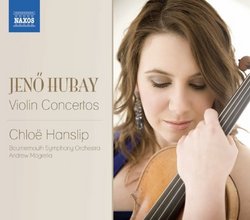| All Artists: Jeno Hubay, Andrew Mogrelia, Bournemouth Symphony Orchestra Title: Hubay: Violin Concertos Members Wishing: 0 Total Copies: 0 Label: Naxos Original Release Date: 1/1/2009 Re-Release Date: 9/29/2009 Genre: Classical Styles: Chamber Music, Forms & Genres, Concertos, Symphonies Number of Discs: 1 SwapaCD Credits: 1 UPCs: 747313207879, 747313207879 |
Search - Jeno Hubay, Andrew Mogrelia, Bournemouth Symphony Orchestra :: Hubay: Violin Concertos
 | Jeno Hubay, Andrew Mogrelia, Bournemouth Symphony Orchestra Hubay: Violin Concertos Genre: Classical |
Larger Image |
CD Details |
CD ReviewsBeautifully Played Romantic Concertos D. A Wend | Buffalo Grove, IL USA | 11/18/2009 (5 out of 5 stars) "Jeno Hubay was born in Pest in 1858; he studied the violin from an early age with his father who was a professor of violin at the national conservatory. He also studied for three years with Joseph Joachim and was a friend of Franz Liszt and Henri Vieuxtemps. Vieuxtemps looked to Hubay to carry on the romantic tradition of the violin concerto and entrusted him with the orchestration of his final concerto. Hubay went on to write four violin concerti and several symphonies.
The Violin Concerto No 1 bears the title "Concerto Dramatique," and it does have its moments of drama but the music is more lyrical and a great vehicle for a virtuoso than a filled with dramatic moments. The concerto was written in 1884 and is dedicated to Joseph Joachim. It shows the influence of Vieuxtemps in the development of the melodies. The concerto begins with a heroic passage for the orchestra giving the soloist a dramatic entrance. The movement develops was a passionate theme that is explored by the soloist with some highly difficult passagework. The music is at time dark but always regains its brightness and lyricism, and closes with a brilliant passage for the soloist punctuated by the orchestra. The slow movement is dreamy. The violinist has long solo passages that make effective use of the instruments singing capabilities. The finale has a passionate melody for soloist and orchestra that turns more turbulent and returns to a joyous melody and concludes the concerto. The Scenes de la Csarda No 3 (The Maros is flowing peacefully) has an immediate Hungarian feel and intricate melodies one associates with Hungarian violin music. The piece has a long lyrical section, a sweet lament, followed by a section of Gypsy music requiring a fantastic display of virtuosity. The Scenes de la Csarda No 4 (Beautiful Katie) begins with a slow section with a bucolic feel to the melody. The rhythm quickly picks up with an energetic Allegro section and develops into a Presto with a marvelous dance. The Violin Concerto No 2 was composed around 1900. A short march-like introduction is followed by the entrance of the soloist playing a passionate melody. The music is developed with the soloist playing pretty much non-stop; the music develops to a climax at the conclusion. The second movement is lyrical developing into a passionate melody. The movement is very heartfelt and ends quietly. The finale is a playful rondo with some difficult passagework for the soloist. The concerto is brought to a joyous conclusion. Chloe Hanslip is plays these demanding works superbly. He playing is particularly remarkable for the stamina required by Hubay: she makes this music her own. Hubay's music is lyrical and filled with lilting melodies. His concerti may not be as memorable as Brahms or Bruch but they are highly satisfying works that contain beautiful melodies and, in the hands of a great violinist, shine. " |
